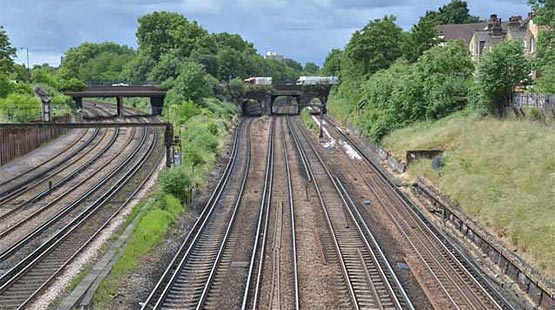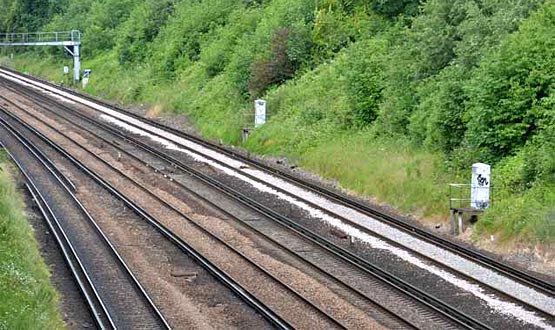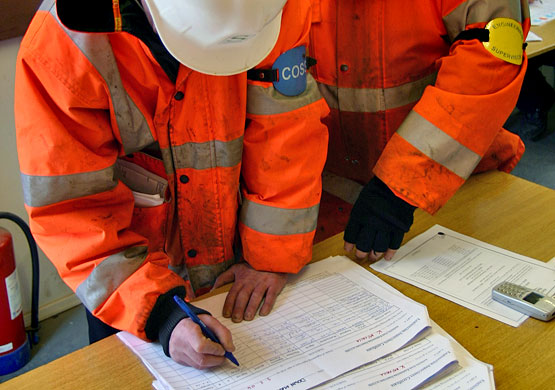|
Austerity demands that the Sword of Damocles looms large over many frontliners. Thankfully the inhabitants of railway office blocks - at least those with a safety role - have been granted immunity to “we’re all in this together” thanks to the determination of the Rail Accident Investigation Branch to keep them busy doing nothing. One of its recent inquiry reports heaps a glut of actions upon them, mostly involving protracted naval gazing and the concoction of more bureaucratic soup.
Between 00:40-04:55 on the morning of Tuesday 8th March 2011, a possession had been booked of the four-track Wessex route between Waterloo and Wimbledon. Two worksites were established in it, the most southerly extending for three miles from Clapham Junction to Wimbledon. The lines are all third-rail electrified and pass through a cutting - this latter characteristic prompting the imposition of a red zone prohibition.
Acting as both ES and COSS within the worksite was the Wimbledon track maintenance depot’s night shift team leader; he was also the track chargeman. His COSS qualification had been held for ten years and he was deemed competent to exploit it through Network Rail’s ‘Assessment in the Line’ process. Three other men were working under him, all of whom only ever worked nights.
The burden borne by the ES/COSS was heavy and the work fell behind, causing the possession to be given up 45 minutes late. At about 03:20, he had received a call from a team of ultrasonic rail testers, elsewhere within the worksite, informing him that they had discovered two defects, one of which was Class 1A - this required clamping and the imposition of a 20mph ESR. At 03:35, the Wessex Integrated Control Centre (WICC) phoned to ask how the defects would be handled. The ES/COSS explained that they were busy with their planned work and he hoped the ultrasonic testers might do the clamping. He would secure a line blockage after the possession was handed back to set up the ESR.
An overview of the location and track layout.
The ES/COSS subsequently arranged for a gang of five men to assemble at Clapham Junction following the conclusion of their other duties with the intention of them installing portable magnets, speed indicators and warning boards at three locations on the Down Main Fast. He phoned one of the gang, asking him to act as COSS and arrange the line blockage. This man had held the qualification for three years although most of his experience had been accrued through daytime patrolling. Meanwhile the ES/COSS would take five other men to Trinity Road access point, from where they would walk out to clamp the defects and erect the ESR commencement and termination boards.
The worksite was given up at 05:00, allowing the PICOP to initiate the tasks that would result in his possession and isolation being relinquished. At 05:17, the Clapham Junction COSS called the signaller to request a line blockage but this was declined as the possession was still in place. He was told to contact the PICOP for access; instead he phoned the ES/COSS, after which he took his group onto the Down Main Fast, briefing them to treat all lines as open as they were not within a worksite. One member was appointed as lookout despite not having a full kit of equipment with him, only a whistle. At 05:39 the PICOP rang the signaller to give up the T3, errantly confirming that, as far as he knew, the ESR had been set up and everyone was clear of the line.
Four minutes later, 5J09 passed through Clapham Junction on the Down Main Fast, travelling empty to Hampton Court under clear signals. Shortly after passing W157 signal, the train encountered the COSS and two members of the workgroup. The lookout blew his whistle to alert the remaining pair who were 300 yards ahead. Refuge was taken in the four-foot of the adjacent lines. The driver neither sounded a warning nor slowed down.

After the first incident, the gang assembled in the grassy wideway between the two sets of lines.
Picture Source: RAIB Rail Accident Report (Crown Copyright)
The gang reassembled in the wideway between the Wessex and Sussex lines. One man phoned the Assistant Track Section Manager to express his concern at the lack of protection. The ATSM instructed the COSS to arrange a line blockage and get the men back to Clapham Junction. The COSS called the ES/COSS to explain the situation, not mentioning the fact that they’d just had a close call. At 05:56 a blockage was secured for a period of 15 minutes.
The COSS again rang the ES/COSS who was waiting with his men at the Trinity Road access. He decided to piggy-back on the line blockage to get the rails clamped and ESR boards erected. Already briefed, the group set off, walking with their backs to traffic along the Down Main Fast. Meanwhile, on arrival back at Clapham Junction, the COSS gave up his protection. All lines were now open once again.
Train 5D91 passed through the station at 06:08, travelling empty to Epsom Sidings under clear signals. The driver received warnings from two portable AWS magnets installed by the first gang and saw the emergency indicator, but not the ESR warning board which had fallen over. His view of the line ahead was obstructed somewhat by a signal post and bridge pier. As the unit passed W169 signal, it was travelling at 46mph.
In the four-foot of the Down Main Fast was the ES/COSS, erecting the termination board. An experienced man, he was in the habit of looking up from time to time. On this occasion he clocked 5D91 approaching and shouted a warning. Another member of the gang dragged two others clear of the line; they crossed the Up Main Fast and scrambled up the banking. By this time, the driver had sounded his horn and applied the emergency brake, the train’s shoegear damaging a conductor rail trough is it came to a stand just where the group had been working. Too late, the Clapham Junction COSS then called, having realised his mistake in surrendering the line blockage.

Following the near miss, the second gang gathered on the slope at the far side of the railway, between the two location cabinets.
Picture Source: RAIB Rail Accident Report (Crown Copyright)
The ES/COSS reported the incident to WICC and the ATSM, receiving instructions to leave everything as it was and return to the depot. He secured a blockage of the Up Main Fast to create a safe walking route back to the access point. No-one thought to inform the signaller that the ESR had not been properly established, leaving trains passing at speed over the unclamped Class 1A defect.
RAIB’s inquiry found that the Clapham Junction COSS thought he was protected by the possession arrangements whilst the ES/COSS thought he was protected by the line blockage. However, in both cases, the arrangements were given up whilst the respective parties were on-track going about their duties. The COSS had briefed his group on the proposed safe system but no-one challenged him about the absence of paperwork - an irrelevance that RAIB is utterly besotted with.
It was the COSS’s first night shift of the week and, by the end of it, tiredness had set in. This was possibly a factor in him forgetting that the ES/COSS was relying on his line blockage. He had been on permanent nights for seven months, working Monday to Thursday. Adjusting his sleep patterns at weekends was proving difficult. Evidence suggests that he felt under pressure to complete the work before the possession was given up and unable to question the perceived instructions of the ES/COSS following the signaller’s refusal to grant a blockage. Collectively those involved were conscious of the need to cause the least possible disruption to train services, hence the haste in setting up the ESR.
The ES/COSS’s reliance on the COSS’s line blockage - again without paperwork - was non-compliant with the rules. These however were impractical in the circumstances as they demanded the appointment of a Protection Controller and for anyone sharing the arrangements to sign the Line Blockage Form, even if their site of work was many miles from where the PC was based - a nonsense that desperately needs addressing. If an ES can sign in with a PICOP by phone, why can’t a COSS come to an understanding with a PC remotely? Inconsistency is one of the Rule Book’s many flaws.
It had been a busy night for the ES/COSS; the stresses imposed might well have affected his judgement. Problems arose with a rail drilling machine, causing the 45-minute overrun; two on-track machines needed moving through the worksite; onerous possession and isolation activities called for his attention - he undertook some of them himself; manpower had to be marshalled to clamp the rail defects and deal with the associated ESR. And in the three hours between 03:00-06:00 he received 68 phone calls, lasting 76 minutes in total. As a consequence he had insufficient opportunity to reflect on the adequacy of the safe system once the possession had been lifted.
Underpinning all of this were problems with the rules. No compliant safe system was available to the Clapham Junction COSS as work within a possession but outside a worksite can only rely on the T3 arrangements if the activity is pre-planned and the PICOP is expecting it. And he couldn’t set up an independent safe system as the use of lookouts is prohibited in darkness unless a 20mph TSR is imposed. He was stuffed basically and unsure how to respond.
|
| He was stuffed basically and unsure how to respond. |
|
RAIB asserts that both incidents would probably have been prevented had there been a requirement for the safe systems to be approved by a competent third party - the implication being that COSSs aren’t sufficiently competent anymore. Leaving aside the time it would take, this is a delightful demonstration of the Branch’s naivety, blissfully ignorant to the reality that, in such circumstances, managers and supervisors will prioritise ‘getting the job done’ over meticulous rule observance any day of the week.
It is though good to see in writing a truth known to every contractor and training company: “Network Rail’s primary competence management system, ‘Assessment in the Line’, was not effective in managing the competence of the ES/COSS and COSS.” Unlike the recerts and interim assessments imposed on the rest of the industry, NR’s staff are deemed proficient on the basis of computer-based tests, often carried out in the most dubious of circumstances. They are ‘open book’ - candidates can look up the answers in relevant publications. Failure is not an option, so it rarely occurs. As a result, many of the firm’s frontliners have gaping holes in their theoretical knowledge and understanding of how rules should be applied. The requirement for line managers to perform on-site ‘surveillance checks’ is simply unworkable given the number of candidates and qualifications, and the infrequency at which the ‘lesser’ duties are undertaken. ‘Assessment in the Line’ is just a paper-driven get-out clause and it’s about time the Office of Rail Regulation recognised it as such.
The inquiry into a derailment at Epsom in September 2006 identified a shortage of track staff at Wimbledon depot as an underlying factor. Three years later, Network Rail assured the ORR that the head count had been increased by 57%. When these latest incidents occurred, one in every five posts there was vacant. With blocking and strapping duties consuming many bodies, this shortfall compromised the team’s ability to effectively complete planned work. Individual workloads were being stretched beyond what was reasonable.

Amongst the recommendations is a review of arrangements for unplanned and emergency work, possibly involving simplification of the relevant rules (not a chance!) and measures to control the risks associated with COSSs planning safe systems at unfamiliar locations. Network Rail should develop proposals for managing the train performance pressures on those setting up protection arrangements in exceptional circumstances. A review of Track Section Managers’ workloads is also advocated. And probably of greatest significance, the training and assessment of track maintenance staff should be examined to determine its adequacy in relation to infrequently-used skills.
There’s plenty here to keep our safety gurus and bureaucrats occupied for a year or three. I’m moist with anticipation at “the provision of clear protocols on communication and coordination arrangements” and the “adoption of situational risk assessments to inform decision making”. Let’s turn our backs, as RAIB has, on the two elephants in the room: ensuring that staffing numbers are sufficient to deal effectively with the job bank and empowering staff, through competence and experience, to make the right choices.
It’s vital to have inquiries. Their value though is compromised by an unwillingness to learn the simplest of lessons. Further tightening of the bureaucratic knot is the preferred solution of the ignorant - if in doubt, throw some process at it. By forcing Network Rail down that path, RAIB will succeed only in compounding the problems that drove these two COSSs into making their misjudgements.
|